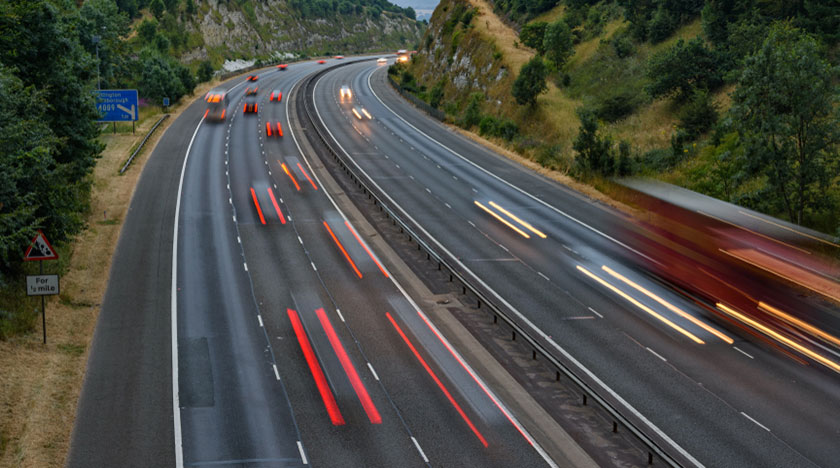There is never a good time to break down, especially if it is the first time it has happened and you are in an unfamiliar location.
If your vehicle starts to warn you something is wrong, or you notice anything out of the ordinary about the vehicle, guidance from the Highway Code suggests that you should leave the motorway at the next exit, or pull into a service area.
However, this is not always possible. In this article, we explore the steps drivers should take if they break down on both traditional and smart motorways.
Breaking down on a traditional motorway
Put your hazards on
The first thing that a driver should do if they notice something is wrong is to put on their hazard lights. This alerts other road users that you are having problems and they can act accordingly.
It’s important to try not to react on instinct, as this could put both yourself and other road users in danger. As soon as it is safe to do so, direct your vehicle to the hard shoulder or as close to the edge of the motorway as possible.
Leave your hazards on, even when your vehicle has come to a stop on the hard shoulder.
Check visibility
This is especially important if you are driving at night, or there is poor visibility (for example, in dense fog, snow or heavy rain). If you think that other road users will be unable to see you, make sure you put on your back-fog lights.
Exit the vehicle on the left
One of the most common mistakes people make when they break down on a motorway is to get out of the vehicle as they normally would. This puts you potentially into the path of oncoming vehicles.
Once your vehicle has come to a stop, make sure that you and any passengers exit the vehicle on the left. This keeps you safe and minimises the risk to other road users.
Leave pets in the car
As hard as it might seem, the Highway Code explains that you need to leave your pet in the vehicle, unless you consider it to be an emergency.
If you do have to take the animal out of the vehicle, then it is vital that they are kept under control at all times. An unrestrained pet and fast-moving vehicles is a recipe for disaster.
Wait behind the barrier, behind your vehicle
Instead of waiting near your vehicle, it is vital that you wait behind the barrier, as far behind your vehicle as it is safe to do so. This helps to protect both yourself and any passengers in the event another road users do not see your vehicle and there is an impact.
If you’re on a motorway, then don’t put a warning triangle behind your vehicle; you should spend as little time standing on the hard shoulder as possible. The only time this is considered safe is if you are on a quiet, single carriageway that has minimal traffic.
Phone for help
The next thing to do is call for help. If you do not have a mobile phone, then you can use one of the emergency phones, located at one-mile intervals along the motorway.
These connect directly to the Highways England or the Police. They will ask you for:
- Your location
- The number of passengers
- Specific details about the breakdown or incident
- If there are any vulnerable people with you (e.g. children, people with disabilities etc)
Returning to your vehicle
If you have walked to one of the emergency phones, then it is time to return to your vehicle. Make sure you stay well away from the carriageway and the hard shoulder.
If you have taken the passengers with you, then make sure everyone walks in single file, if possible. Ideally, you should walk behind the barrier to ensure that everyone is as far away from the carriageway as possible.
Rejoining the motorway
Once your vehicle has been restarted or the fault has been fixed, then it’s time to rejoin the motorway. Wait for a gap in the traffic, but if one doesn’t present itself, then be patient.
If possible, it’s advised that you use the hard shoulder to build up speed before you rejoin the traffic flow. This helps to reduce the need for other road users to avoid you, and significantly reduces the risk of someone hitting your vehicle.
Breaking down on a smart motorway
With the rise in smart motorway development, it is now more important than ever to understand how to react if you break down on one of these roads. During busier times, there may not be a hard shoulder to drive to. The process is fairly similar to breaking down on a traditional motorway, but the steps you should take include:
- Stop at a designated Emergency Refuge Area (ERA), motorway service area or leave at the next available junction.
- If this is not possible, then go through the same steps (hazard lights and manoeuvre) to get the vehicle off the carriageway
- If you have managed to get to the left-hand lane, and if it is safe to do so, leave the vehicle on the left and wait behind the barrier
- If you can’t leave the vehicle, or find yourself broken down in the middle or right-hand lane, put your hazards on and call 999
- If you have stopped in an ERA, then you must use the SOS phone to contact the Regional Control Centre (RCC). You must do this as soon as you have stopped, and again before you leave
It’s vital to remember that your safety, and the safety of other road users is the highest priority. You might have some knowledge of repairing vehicles, but it is always advisable that you contact a breakdown service, the Highways England or the Emergency Services should you find yourself in this situation.
They are trained to help motorists that have broken down, and have the processes in place to ensure that any further accidents are prevented.
We hope that you have found this guide useful, but if you would like any further information on what you have read, then do get in touch with one of our team on 03338 803042 or email us


